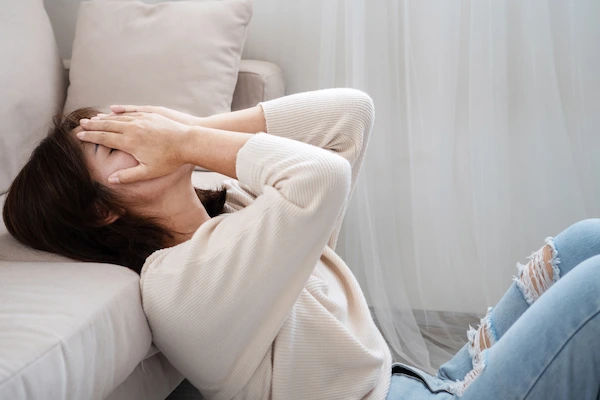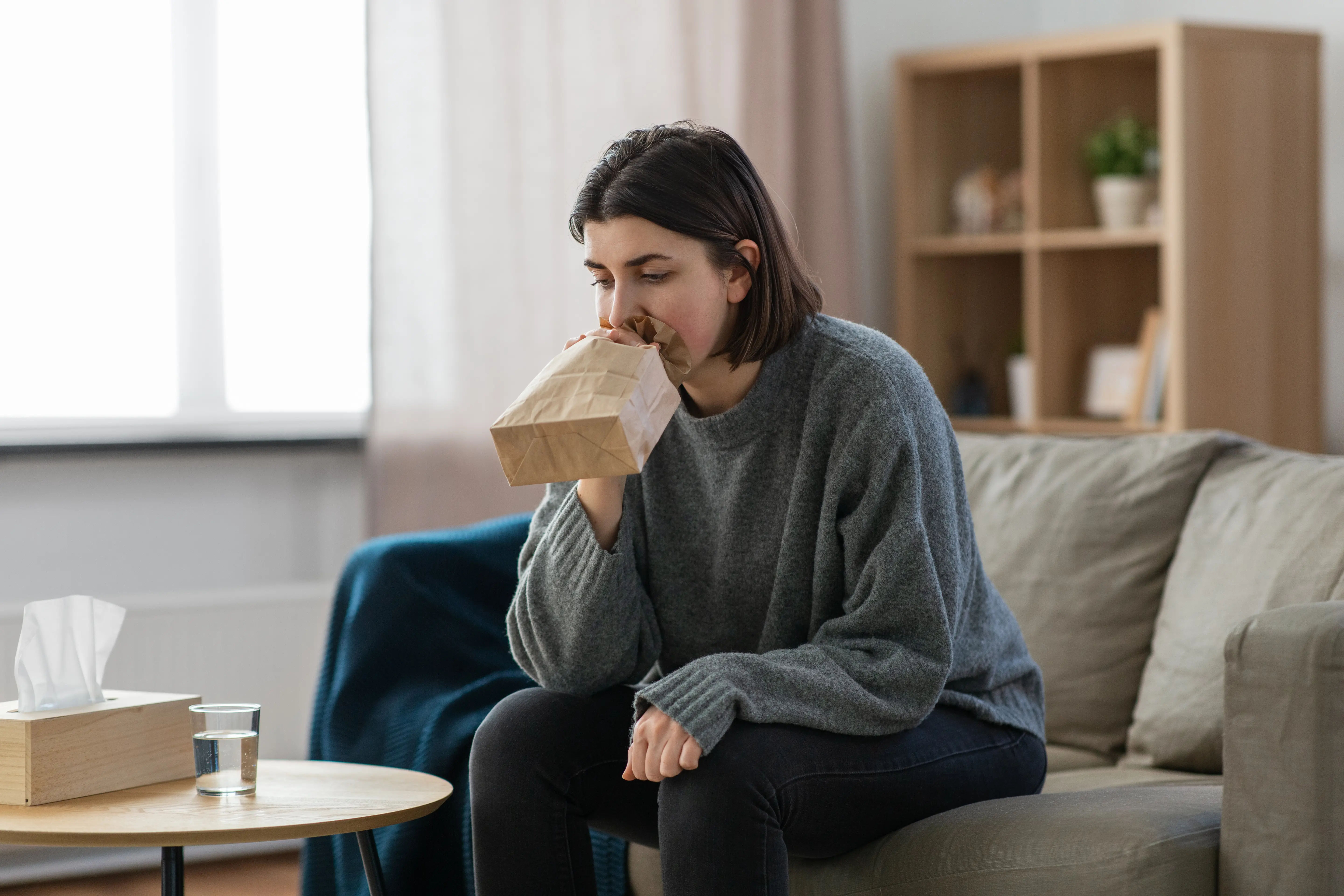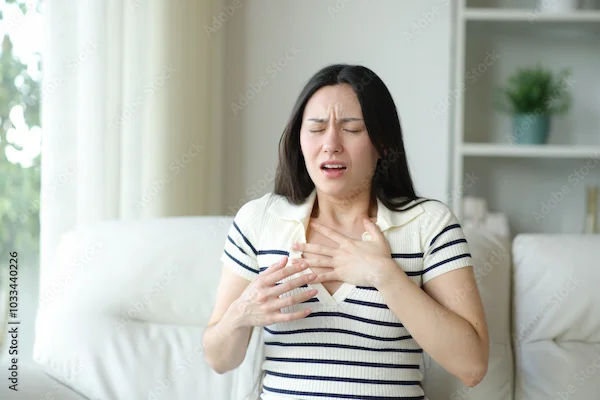What Leads to Signs of Panic Attacks? Causes, Triggers, and How to Get Help
Learn what leads to signs of panic attacks, common triggers, symptoms, and evidence-based treatments. Discover practical self-help strategies and how Apollo24|7 can support you.


Introduction
If you’ve ever felt your heart race, your breath shorten, and a sudden fear that something terrible is about to happen, you’re not alone. Panic attacks can be overwhelming—but they’re also highly treatable. In this guide, you’ll learn what leads to the signs of panic attacks, how to recognise triggers, and what to do in the moment. We’ll cover the science behind panic, medical conditions that can look similar, and expert-backed treatments that really work. You’ll also find practical tools you can use today—like breathing techniques, sleep and caffeine strategies, and a step-by-step plan for riding out an attack. And if symptoms persist, we’ll show you where to get help quickly and safely. Whether you experience panic attacks yourself or want to support a loved one, this article will give you a clear, compassionate roadmap for understanding and managing panic attacks.
Panic Attacks at a Glance: What They Are and Why They Feel So Intense
Here's what this section covers:
A quick definition vs. panic disorder
A panic attack is a sudden surge of intense fear or discomfort that peaks within minutes, accompanied by physical and cognitive symptoms such as palpitations, chest pain, shortness of breath, dizziness, trembling, or fear of losing control or dying. Panic disorder is diagnosed when recurrent, unexpected panic attacks are followed by persistent worry about having more attacks or significant behaviour changes (like avoidance) for at least a month.
How common are panic attacks?
Many people experience at least one panic attack in their lifetime. Panic disorder affects about 2–3% of adults in a given year, with lifetime prevalence around 4–5%. Panic attacks often begin in late adolescence or early adulthood but can occur at any age. They can occur with or without a diagnosable panic disorder.Consult Top Specialists
The Signs of Panic Attacks: What You May Notice in Your Body and Mind
Here's what this section covers:
Physical signs
Common physical signs include a pounding heart, chest pain or tightness, shortness of breath, hyperventilation, sweating, hot/cold flushes, shaking, nausea, dizziness or lightheadedness, tingling or numbness (especially around the mouth, hands, or feet), and a sense of choking. Many of these sensations are driven by adrenaline release and rapid breathing.
Cognitive and emotional signs
Mentally, people often report fear of losing control, “going crazy,” or dying. Feelings of depersonalisation (feeling detached from yourself) or derealisation (feeling like the world isn’t real) can appear. This can be frightening but is reversible and a known part of panic attacks.
The typical timeline: onset, peak, and wind-down
Panic attacks usually come on quickly, peak within about 10 minutes, and resolve within 20–30 minutes, though residual fatigue or unease may linger. The duration can vary; nocturnal panic attacks can awaken you from sleep with symptoms peaking just as fast.
Why Panic Attacks Happen: The Science Behind the “Alarm System”
Here's what this section covers:
Fight-or-flight, adrenaline, and hyperventilation
Your autonomic nervous system activates fight-or-flight when it perceives threat. Adrenaline increases heart rate, breathing, and blood flow to muscles. If you breathe too fast (hyperventilate), carbon dioxide (CO2) drops, which can cause dizziness, tingling, and chest discomfort—sensations that can fuel more fear.
The panic cycle: misinterpreting sensations and feedback loops
A core driver is catastrophic misinterpretation: noticing a benign sensation (like a skipped heartbeat) and interpreting it as dangerous (“I’m having a heart attack”). This spikes anxiety, which intensifies bodily sensations, which increases fear—a loop called the panic cycle. Cognitive-behavioural therapy (CBT) targets this loop by changing interpretations and intentionally recreating benign bodily sensations (interoceptive exposure) to retrain your alarm system.
Common Triggers and Risk Factors You Can Recognise
Here's what this section covers:
External triggers (stress, conflict, crowds)
Acute stressors—relationship conflict, occupational pressure, financial concerns, or major life changes—can heighten your baseline arousal and increase the likelihood of panic attacks. Crowded or confined spaces (public transport, busy malls) can act as situational triggers, especially if you had prior attacks there.
Internal triggers (caffeine, sleep loss, hormones)
Internal states often precipitate panic attacks. High caffeine intake or energy drinks can trigger palpitations and jitteriness that mimic panic and can precipitate an episode (“caffeine induced panic attack”). Sleep deprivation increases amygdala reactivity, raising the odds of alarm misfires. Hormonal shifts (PMS, postpartum, perimenopause) may also sensitise the nervous system.
Personal risk factors (family history, temperament, trauma)
Genetics play a role—having a first-degree relative with panic disorder raises risk. Temperamental traits like negative affectivity (neuroticism) and heightened anxiety sensitivity increase vulnerability to misinterpreting bodily cues. Trauma or adverse childhood experiences can prime the stress response system, making panic more likely in stressful periods.
Medical Conditions and Substances That Mimic or Provoke Panic
Here's what this section covers:
Thyroid, anemia, heart rhythm issues, asthma
Several medical conditions can produce panic-like symptoms: hyperthyroidism (racing heart, tremor), anemia (palpitations, breathlessness), arrhythmias (irregular heartbeat), asthma (air hunger), and vestibular issues (dizziness). Hypoglycaemia can cause shakiness, sweating, and anxiety-like symptoms. A medical evaluation helps distinguish these from primary panic attacks.
Stimulants, alcohol, medications, withdrawal
Substances matter. High-dose caffeine, nicotine, decongestants (pseudoephedrine), some asthma medications (albuterol), and illicit stimulants can trigger attacks. Alcohol may briefly reduce anxiety but can cause rebound anxiety and nocturnal panic as it wears off. Withdrawal from benzodiazepines or alcohol can produce panic-like symptoms.
When to consider lab tests and medical evaluation
If panic-like symptoms are new, severe, or accompanied by red flags (fainting, sustained chest pain, new neurological deficits), a medical check is important. Tests may include thyroid function (TSH, free T4), complete blood count (for anemia), ECG (for rhythm issues), and glucose levels. If these issues are suspected or symptoms persist beyond two weeks, consult a doctor online with Apollo 24|7 for further evaluation; Apollo 24|7 also offers convenient home collection for tests like thyroid profile, CBC, vitamin D, or HbA1c when relevant.Consult Top Specialists
Diagnosis: Panic Attack vs Anxiety Attack vs Heart Attack vs Panic Disorder
Here's what this section covers:
DSM-5 criteria and what clinicians assess
Clinicians assess the pattern (unexpected vs situational), frequency, anticipatory anxiety, avoidance behaviours, and impact on daily life. Panic disorder is diagnosed when recurrent unexpected panic attacks are followed by one month or more of persistent concern or behavioural change. They also screen for agoraphobia, depression, substance use, and medical mimics. NICE guidance recommends stepped care and CBT as first-line psychological treatment.
Key differences to help you decide next steps
• Panic attack vs anxiety attack: “Anxiety attack” is a nonclinical term usually describing gradual anxiety build-up; panic attacks are abrupt and intense, peaking within minutes.
• Panic attack vs heart attack: Panic often features sharp chest pain, hyperventilation, and fear of losing control; heart attack pain tends to be pressure-like, may radiate to arm/jaw, and occurs with exertion or at rest with risk factors. When in doubt—especially with new chest pain—seek urgent medical care.
• Nocturnal panic attacks: Sudden awakenings with panic symptoms; evaluation is useful to rule out sleep apnoea or reflux, which can contribute.
Evidence-Based Treatments That Work
Here's what this section covers:
CBT with interoceptive exposure
CBT remains the gold standard for panic disorder, focusing on reframing catastrophic thoughts and gradually exposing you to feared sensations (e.g., safe spinning to mimic dizziness, straw breathing to simulate breathlessness) until the sensations lose their threat value. This rewires the alarm system and reduces both frequency and intensity of panic attacks.
Medications: SSRIs/SNRIs, beta-blockers, cautious benzodiazepine use
Antidepressants such as SSRIs (e.g., sertraline, fluoxetine) and SNRIs can reduce panic frequency and severity and are recommended first-line pharmacotherapy. Beta-blockers can help situationally with physical symptoms (e.g., presentations). Benzodiazepines may provide short-term relief but can cause dependence and may interfere with exposure therapy; they’re typically used short-term under medical guidance.
Digital tools and brief interventions
App-based CBT programs and therapist-guided telehealth can expand access. Some people benefit from brief interventions like a single-session crisis plan or digital biofeedback for breathing. If your condition does not improve after trying these methods, book a physical visit to a doctor with Apollo 24|7 to personalise your plan.
Self-Help Strategies and Prevention You Can Start Today
Here's what this section covers:
During an attack: grounding, paced breathing, CO2 tolerance tips
• Label and normalise: “This is a panic attack. My body is safe. It will peak and pass.”
• 5-4-3-2-1 grounding: Name five things you see, four you feel, three you hear, two you smell, one you taste.
• Paced breathing: Inhale 4 seconds, hold 1, exhale 6; or 4-7-8 pattern. Focus on long exhales to raise CO2 and reduce dizziness/tingling.
• Soft gaze and gentle movement: Release shoulder and jaw tension; slow face and hand movements can dampen sympathetic arousal.
Between attacks: sleep, exercise, caffeine/alcohol strategies
• Sleep: Aim for consistent sleep; insufficient sleep heightens alarm sensitivity.
• Exercise: 150 minutes/week of moderate activity can reduce anxiety sensitivity; interoceptive exposure via exercise can be therapeutic.
• Caffeine/alcohol: Reduce afternoon caffeine and energy drinks; moderate or avoid alcohol to prevent rebound anxiety.
• Nutrition: Regular meals to avoid hypoglycaemia-like symptoms.
Building a personalised panic plan
Create a one-page plan: triggers, early signs, steps (breathing, grounding), coping statements, support contacts, and a “when to seek help” checklist. Share with a trusted person. This plan helps shift from fear to action.
When to Seek Help, and How Apollo 24|7 Can Support You
Here's what this section covers:
Red flags for urgent care
Seek emergency care for new or severe chest pain, fainting, signs of stroke (one-sided weakness, facial droop, speech difficulty), severe shortness of breath, or if you have heart disease risk factors and symptoms feel different from prior panic attacks. If you have thoughts of self-harm, seek immediate help via emergency services or your local crisis line.
When to consult a clinician online vs. in person
Consult a clinician if you’ve had recurrent panic attacks, you’re avoiding places or activities, or symptoms persist beyond two weeks. If you’re starting to limit your life, timely care can prevent progression to agoraphobia. You can consult a doctor online with Apollo 24|7 for evaluation and a treatment plan, including therapy and medication options. If indicated, Apollo 24|7 offers convenient home collection for tests such as thyroid function, CBC, or HbA1c to rule out contributing medical factors.
Conclusion
Panic attacks can feel frightening, but they are understandable—and changeable. Recognising the signs of panic attacks, learning how and why they arise, and identifying your personal triggers puts you back in control. With proven treatments like CBT and, when appropriate, medications such as SSRIs, most people regain confidence and return to the activities that matter to them. Practical daily tools—paced breathing, grounding, smart caffeine and sleep strategies—help lower your baseline stress and prevent the panic cycle from taking hold. If your symptoms persist beyond two weeks, or you’ve begun avoiding places or activities for fear of another attack, consider reaching out. You can consult a doctor online with Apollo 24|7 for timely assessment, treatment options, and support. If needed, Apollo 24|7 also provides convenient home collection for basic tests to rule out medical contributors. The path through panic is real and well mapped—one step, one breath, one conversation at a time.Consult Top Specialists
Consult Top Specialists

Mr. Aman Kochhar
Psychologist
2 Years • MA - Psychology, Post Graduate Diploma In Guidance and Counselling
New Delhi
Well-mind Counselling, New Delhi

Ms. Mansi Kothari
Psychologist
7 Years • MA - Psychology
Gurugram
Soulful, Gurugram
(75+ Patients)

Ms. Sharmila Mazumdar
Psychologist
15 Years • Dip in Mental health , Advanced counselling and Psychotherapy.
Kolkata
MCR SUPER SPECIALITY POLY CLINIC & PATHOLOGY, Kolkata

Ms. Moumita Ganguly
Psychologist
13 Years • B.ED(Special) Visual Impairment , PG.Diploma in Rehabilitation psychology
Kolkata
M’s Clinic, Kolkata
(125+ Patients)

Dr. Richa Kumari
Psychiatrist
10 Years • MBBS, DPM (Psychiatrist)
Bangalore
Apollo Clinic Bellandur, Bangalore
(175+ Patients)
Consult Top Specialists

Mr. Aman Kochhar
Psychologist
2 Years • MA - Psychology, Post Graduate Diploma In Guidance and Counselling
New Delhi
Well-mind Counselling, New Delhi

Ms. Mansi Kothari
Psychologist
7 Years • MA - Psychology
Gurugram
Soulful, Gurugram
(75+ Patients)

Ms. Sharmila Mazumdar
Psychologist
15 Years • Dip in Mental health , Advanced counselling and Psychotherapy.
Kolkata
MCR SUPER SPECIALITY POLY CLINIC & PATHOLOGY, Kolkata

Ms. Moumita Ganguly
Psychologist
13 Years • B.ED(Special) Visual Impairment , PG.Diploma in Rehabilitation psychology
Kolkata
M’s Clinic, Kolkata
(125+ Patients)

Dr. Richa Kumari
Psychiatrist
10 Years • MBBS, DPM (Psychiatrist)
Bangalore
Apollo Clinic Bellandur, Bangalore
(175+ Patients)
Consult Top Specialists

Mr. Aman Kochhar
Psychologist
2 Years • MA - Psychology, Post Graduate Diploma In Guidance and Counselling
New Delhi
Well-mind Counselling, New Delhi

Ms. Mansi Kothari
Psychologist
7 Years • MA - Psychology
Gurugram
Soulful, Gurugram
(75+ Patients)

Ms. Sharmila Mazumdar
Psychologist
15 Years • Dip in Mental health , Advanced counselling and Psychotherapy.
Kolkata
MCR SUPER SPECIALITY POLY CLINIC & PATHOLOGY, Kolkata

Ms. Moumita Ganguly
Psychologist
13 Years • B.ED(Special) Visual Impairment , PG.Diploma in Rehabilitation psychology
Kolkata
M’s Clinic, Kolkata
(125+ Patients)

Dr. Richa Kumari
Psychiatrist
10 Years • MBBS, DPM (Psychiatrist)
Bangalore
Apollo Clinic Bellandur, Bangalore
(175+ Patients)
More articles from Panic attacks and panic disorder
Frequently Asked Questions
1. What triggers panic attacks at night?
Nocturnal panic attacks can be triggered by sleep deprivation, alcohol, reflux, or sleep apnoea; internal bodily changes during sleep can also spark the alarm response. Track sleep, reduce alcohol, and consult a clinician if episodes persist to rule out medical contributors such as apnoea.
2. How can I stop a panic attack fast?
Use long, slow exhales (e.g., 4 in, 6–8 out), grounding (5-4-3-2-1), and compassionate labelling (“This will pass.”). A “panic plan” card helps. Over time, interoceptive exposure reduces the intensity and frequency of attacks.
3. What’s the difference between a panic attack and an anxiety attack?
“Anxiety attack” isn’t a formal diagnosis; it typically refers to gradual anxiety with identifiable stressors. Panic attacks are abrupt, intense surges that peak within minutes with physical symptoms like chest pain and dizziness.
4. Can caffeine cause panic attacks?
Yes. Caffeine stimulates the nervous system and can mimic or trigger panic symptoms (palpitations, jitteriness). Reducing or timing caffeine earlier in the day often helps prevent attacks.
5. Do I need medication for panic disorder?
Not always. CBT is highly effective; SSRIs/SNRIs are evidence-based options if needed. Work with a clinician to choose a plan that fits your symptoms and preferences. If your condition does not improve after trying self-help methods, book a physical visit to a doctor with Apollo 24|7.



